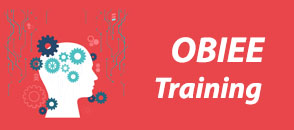


![]() Online Training
Online Training
![]() Corporate Training
Corporate Training
![]() ON Demand
ON Demand
This OBIEE 12c five-day course covers the entire gamut of Oracle's Flagship BI product. It includes developing reports and dashboards from scratch as well as the new features in 12c. Data Mashup and the Visual Analyzer are featured prominently. The course assumes no prior knowledge however users with 11g experience will benefit from learning the new features.
The course starts by covering basic reporting, dashboards and analysis including use of the new Visual Analyser tool; then, the focus moves onto the data and repository layer showing you how to create an BI Repository (RPD) against both transactional and data warehouse databases. The final day of the course covers systems management including the new Baseline Validation Tool, and takes attendees through OBIEE 12c underlying architecture including security and the installation process.
There are no prerequisites.
This course is designed for Developers, Consultants, Project Managers, Tech Leads, and DBAs.
Expert Instructors
Practical Implementation
Real- time Case Studies
Certification Guidance
Resume Preparation
Placement Assistance
Copyright 2018 © www.unitedglobalsoft.com . All right reserved | Sitemap | Privacy Policy | Terms Of Services